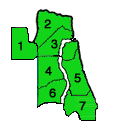
THE HIGH PERFORMANCE TREE SERVICE TEAM YOU CAN DEPEND ON
IN FLEMING ISLAND FLORIDA
HP Tree Service work is performed to
Tree Care Industry Association Standards.
An arborist is a person that performs tree care services. These tree care services may include tree pruning, tree removal, tree spraying, tree fertilization, or even tree planting. Many arborists can also diagnose tree problems such as how to control insect pests on trees or how to control tree diseases. Arborists often work for tree services, but they may also be city foresters or work for themselves as tree care consultants. If an arborist has enough tree care experience, or a university degree in forestry or a horticultural field, he/she may decide to become an ISA Certified Arborist. The International Society of Arboriculture certifies arborists that have attained the necessary experience to qualify to take the arborist exam. The ISA’s Certified Arborist exam is extensive and covers all aspects of tree care. The ISA Certified Arborist credential is not simply a matter of passing the certification exam one time. The ISA Certified Arborist credential lasts only three years. To maintain certification the ISA Certified Arborist must either have accumulated 30 hours of continuing education units in three years or he/she must retake the certified arborist exam to retain their certification. ISA certification is voluntary and doesn’t guarantee the arborist will perform tree care services to industry standards. The certification does indicate the arborist has experience performing tree care services and has passed an extensive examination that covers all aspects of tree care. ISA certification also indicates a certain amount of commitment on the part of the arborist to keep up to date on the ever expanding research and changes within the tree care industry.
Arborists.
An arborist usually starts a tree service or works for a tree service to save trees, not remove trees. Nonetheless, trees have a lifespan and tree removal will eventually be necessary. Tree removal, especially removal of large trees, is best handled by an arborist that is experienced and carries the proper liability insurance.

Tree Fertilization.
An often overlooked tree care service is tree fertilization. Many homeowners don’t realize the need to have tree fertilization done because trees in the forest seem to grow without tree fertilization. However, an arborist can explain that there are significant differences in the growing environment between forest trees and landscape trees. There are several tree fertilization techniques available to an arborist to make sure your trees remain as healthy as possible.

Tree Spraying.
The tree species is often the determining factor as to whether tree spraying is necessary. Some tree species, like Maple trees, are rarely in need of tree spraying. Other tree species, like certain Crabapple tree varieties, may require tree spraying every year to control insect pests or tree diseases. A local arborist will usually know what tree species is susceptible to insect pest or tree diseases in your area.

We love what we do.
A person that takes care of trees for a living is referred to as an arborist. An arborist that takes the care of trees seriously often becomes a Certified Arborists through the International Society of Arboriculture. A local tree service that desires to stay informed and provide quality tree care will sometimes join local or national arboriculture related organizations such as the Tree Care Industry Association.
Stump Grinding.
After a tree service completes a tree removal all that remains is the tree stump. In the past it was thought that grinding a tree stump was optional. If the tree stump was in a remote location in your landscape, it could be left to decay naturally. More recent research, however, indicates that grinding out tree stumps may help protect other trees in your landscape. Decay fungi that might attack your other trees could become established on stumps left in the landscape after a tree removal. These fungi use existing stumps as a food source and then become established in your landscape. If one of your other trees is wounded in the future the decay fungi then has the opportunity to colonize the wounded tree.
If you contract stump removal with your local tree service they may grind a tree stump the same day as the tree removal or their arborist may return later to do the stump grinding.

